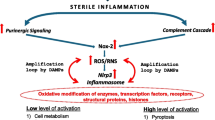Abstract
Invertebrate circulating hemocytes are key players in the innate immune defense and their continuous renewal from hematopoietic tissues is tightly regulated in crustaceans by astakine, a new family of cytokines sharing a prokineticin (PROK) domain. In vertebrates, brain PROKs function as transmitters of circadian rhythms and we present evidence that hemocyte release from hematopoietic tissues in crayfish is under circadian regulation, a direct result of rhythmic expression of astakine. We demonstrate that the observed variation in astakine expression has an impact on innate immunity assessed as susceptibility to a pathogenic Pseudomonas species. These findings enlighten the importance of comparing immune responses at fixed times not to neglect circadian regulation of innate immunity. Moreover, our results entail an evolutionary conserved function for prokineticins as mediators of circadian rhythm, and for the first time show a role for this domain in circadian regulation of hematopoiesis that may have implications also in vertebrates.






Similar content being viewed by others
Abbreviations
- HLS:
-
Hemocyte lysate supernatant
- HPT:
-
Hematopoietic tissue
- PROK:
-
Prokineticin
- SCN:
-
Suprachiasmatic nucleus
References
Gimble JM, Floyd ZE, Bunnell BA (2009) The 4th dimension and adult stem cells: can timing be everything? J Cell Biochem 107:569–578
Méndez-Ferrer S, Chow A, Merad M, Frenette PS (2009) Circadian rhythms influence hematopoietic stem cells. Curr Opin Hematol 16:235–242
Lee JE, Edery I (2009) Circadian regulation in the ability of Drosophila to combat pathogenic infections. Curr Biol 18:195–199
Söderhäll I, Bangyeekhun E, Mayo S, Söderhäll K (2003) Hemocyte production and maturation in an invertebrate animal; proliferation and gene expression in hematopoietic stem cells of Pacifastacus leniusculus Dev. Comp Immunol 27:661–672
Lebetsky T, Chang T, Hartenstein V, Banerjee U (2000) Specification of Drosophila hematopoietic lineage by conserved transcription factors. Science 288:146–149
Wu C, Kim YA, Liu HP, Söderhäll I, Söderhäll K (2008) Hemocyte lineage marker proteins in a crustacean, the freshwater crayfish Pacifastacus leniusculus. Proteomics 8:4226–4235
Söderhäll I, Kim YA, Jiravanichpaisal P, Lee SY, Söderhäll K (2005) An ancient role for a prokineticin domain in invertebrate hematopoiesis. J Immunol 174:6153–6160
Lin X, Söderhäll K, Söderhäll I (2008) Transglutaminase activity in the hematopoietic tissue of a crustacean, Pacifastacus leniusculus, important in hemocyte homeostasis? BMC Immunol 9:58
Kaser A, Winklmayr M, Lepperdinger G, Kreil G (2003) The AVIT protein family. Secreted cysteine-rich vertebrate proteins with diverse functions. EMBO Rep 4:469–473
Lin X, Kim YA, Lee BL, Söderhäll K, Söderhäll I (2009) Isolation and properties of a receptor for the invertebrate cytokine astakine, involved in hematopoiesis. Exp Cell Res 315:1171–1180
Boisbouvier J, Albrand JP, Blackledge M, Jaquinod M, Schweitz H, Lazdunski M, Marion D (1998) A structural homologue of colipase in black mamba venom revealed by NMR floating disulphide bridge analysis. J Mol Biol 283:205–219
Mollay C, Wechselberger C, Mignogna G, Negri L, Melchiorri P, Barra D, Kreil G (1999) Bv8, a small protein from frog skin and its homolog from snake venom induce hyperalgesia in rats. Eur J Pharmacol 374:189–196
Negri L, Lattanzi R, Giannini E, Canestrelli M, Nicotra A, Melchiorri P (2009) Bv8/Prokineticins and their receptors: a new pronociceptive system. Int Rev Neurol 85:145–157
Monnier J, Samson M (2008) Cytokine properties of prokineticins. FEBS J 275:4014–4020
Dorsch M, Qui Y, Soler D, Frank N, Duong T, Goodearl A, O′Neil S, Lora J, Fraser CC (2005) PK1/EG-VEGF induces monocyte differentiation and activation. J Leukoc Biol 78:426–434
Monnier J, Quillien V, Piquet-Pellore C, Leberre C, Preisser L, Gascan H, Samson M (2008) Prokineticin 1 induces CCL4, CXCL1 and CXCL8 in human monocytes but not in macrophages and dendritic cells. Eur Cytokine Netw 19:166–175
Martucci C, Franchi S, Giannini E, Tian H, Melchiorri P, Negri L, Sacerdote P (2006) Bv8, the amphibian homologue of the mammalian prokineticins induces a proinflammatory phenotype of mouse macrophages. Br J Pharmacol 147:225–234
Zhou OY, Cheng MY (2005) Prokineticin 2 and circadian clock output. FEBS J 272:5703–5709
Zhang C, Truong KK, Zhou QY (2009) Efferent projections of prokineticin 2 expressing neurons in the mouse suprachiasmatic nucleus. PLoS ONE 4:e7151
Cerenius L, Liang Z, Duvic B, Keyser P, Hellman U, Palva ET, Iwanaga S, Söderhäll K (1994) Structure and biological activity of a 1, 3-beta-d-glucan-binding protein in crustacean blood. J Biol Chem 25:29462–29467
Goergen EM, Bagay LA, Rehm K, Benton JL, Beltz BS (2002) Circadian control of neurogenesis. Int J Neurobiol 53:90–95
Castanon-Cervantes O, Battelle B, Fanjul-Moles ML (1999) Rhythmic changes in serotonin content of the brain and eyestalk of crayfish during development. J Exp Biol 202:2823–2830
Sullivan JM, Genco MC, Marlow ED, Benton JL, Beltz BS, Sandeman DC (2009) Brain photoreceptor pathways contributing to circadian rhythmicity in crayfish. Chronobiol Int 26:1136–1168
Jiravanichpaisal P, Roos S, Edsman L, Liu H, Söderhäll K (2009) A highly virulent pathogen, Aeromonas hydrophila, from the freshwater crayfish Pacifastacus leniusculus. J Invertebr Pathol 101:56–66
Méndez-Ferrer S, Lucas D, Battista M, Frenette PS (2008) Haematopoitic stem cell release is regulated by circadian oscillations. Nature 452:442–447
Le Couter J, Zlot C, Tejada M, Peale F, Ferrara N (2004) Bv8 and endocrine gland-derived vascular endothelial growth factor stimulate hematopoiesis and hematopoietic cell mobilization. Proc Natl Acad Sci USA 101:16813–16818
Womac AD, Burkeen JF, Neuendorff N, Earnest DJ, Zoran MJ (2009) Circadian rhythms of extracellular ATP accumulation in suprachiasmatic nucleus cells and cultured astrocytes. Eur J Neurosci 30:869–876
Acknowledgments
This work was financed by the Swedish Science Research Council and Formas.
Author information
Authors and Affiliations
Corresponding author
Rights and permissions
About this article
Cite this article
Watthanasurorot, A., Söderhäll, K., Jiravanichpaisal, P. et al. An ancient cytokine, astakine, mediates circadian regulation of invertebrate hematopoiesis. Cell. Mol. Life Sci. 68, 315–323 (2011). https://doi.org/10.1007/s00018-010-0458-8
Received:
Revised:
Accepted:
Published:
Issue Date:
DOI: https://doi.org/10.1007/s00018-010-0458-8




